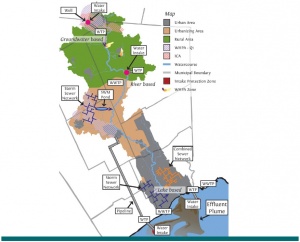Managing Costs and Containing Risks using the One Water Approach
Municipalities should employ a One Water approach to explore the interconnections between water systems and to make the most informed water management decisions.
Using this approach will help to: a) ensure that water infrastructure systems deliver the appropriate level of service to human populations, and b) minimize negative impacts on other water systems, including natural systems like aquifers, streams, and lakes.
Making the transition to a integrated water management framework will support municipalities and other decision makers in addressing a complex system of drivers and risks. Such drivers and risks include aspects related to climate change, urban development, redevelopment and intensification of existing areas. Failing infrastructure – and the cost of its repair and replacement – is one example of risks. A 2007 survey carried out by the Federation of Canadian Municipalities (FCM) and McGill University survey found that the estimated water infrastructure deficit in Canada was $31 billion for existing infrastructure, plus $56.6 billion for new infrastructure needs, including water, wastewater and stormwater systems (FCM, 2007). Since the One Water approach considers these systems in a systematic, integrated manner, it can help water managers identify cost-effective solutions that can impact and improve multiple systems. It can also help municipalities determine and prioritize investments based on benefits to residents and the watershed.
Rainwater harvesting is one simple example of a cost-effective solution which yields multiple benefits. By providing an alternative water source for activities that do not require potable water, such as gardening or flushing toilets, residents use less municipal drinking water – which is expensive and energy intensive to treat and distribute.
For some municipalities, including the City of Toronto, Region of Peel, and City of Guelph, treating and distributing water can account for 25% to 60% of total municipal electricity costs. There, the One Water approach can provide conservation not only of water, but of energy. This relationship is known as the water-energy nexus. Additionally, capturing rainwater decreases the flow of water to municipal stormwater management systems, which can alleviate stress on older systems that lack capacity for high volumes of water, potentially reducing instances of flooding and erosion. The alleviation of such stresses is akin to finding ‘hidden capacity’ within an existing system, and can result in the deferment of expensive system upgrades if implemented on a broad enough scale. The One Water approach emphasises solutions that offer multiple benefits. To properly evaluate these solutions, it is helpful to consider water management through the lens of the watershed.
The Watershed Perspective[edit]

As noted in previous section, the watershed scale is an appropriate spatial scale for many water infrastructure and water management decisions, as it is a functional response unit. While working to employ the precepts of the One Water approach within a municipal water planning framework, it is helpful to start with the watershed as a foundational perspective. The watershed perspective reveals the complex, manifold ways in which water systems – natural and built – are connected. Understanding these layers, how they are linked, and how a watershed functions will support cost-effective, holistic municipal water and land management. It will also make clear many types of levels of risk which otherwise may not have been revealed. For example, a rainfall event might lead to contaminated stormwater runoff draining to drinking water supply intake locations. A watershed approach not only encourages the identification of these types of risks, but also makes it easier to determine potential solutions to mitigate problems. Efforts to minimize risk can encourage municipalities to work together on integrated planning and management solutions, since watersheds cross political boundaries.
Phased implementation[edit]
The purpose of this section of the wiki guide is to provide direction on how to follow a phased approach to completing a water sustainability plan. It is a tool that water managers can use to streamline planning efforts, reduce costs, and coordinate decisions and management tasks relating to water infrastructure. This section also includes suggestions on how to expand upon existing information to fill data gaps within a given study area. It will also provide linkages to – and build upon - many external resources produced by the STEP partners that give further guidance and consideration to matters which impinge upon sustainable planning and the One Water approach, including matters pertaining to climate change, asset management, risk assessment and more. To ensure that we are making informed water management decisions and developing only the most prudent stormwater designs it is critical that we accept and embrace the intrinsically interconnected nature of water resources in Ontario.